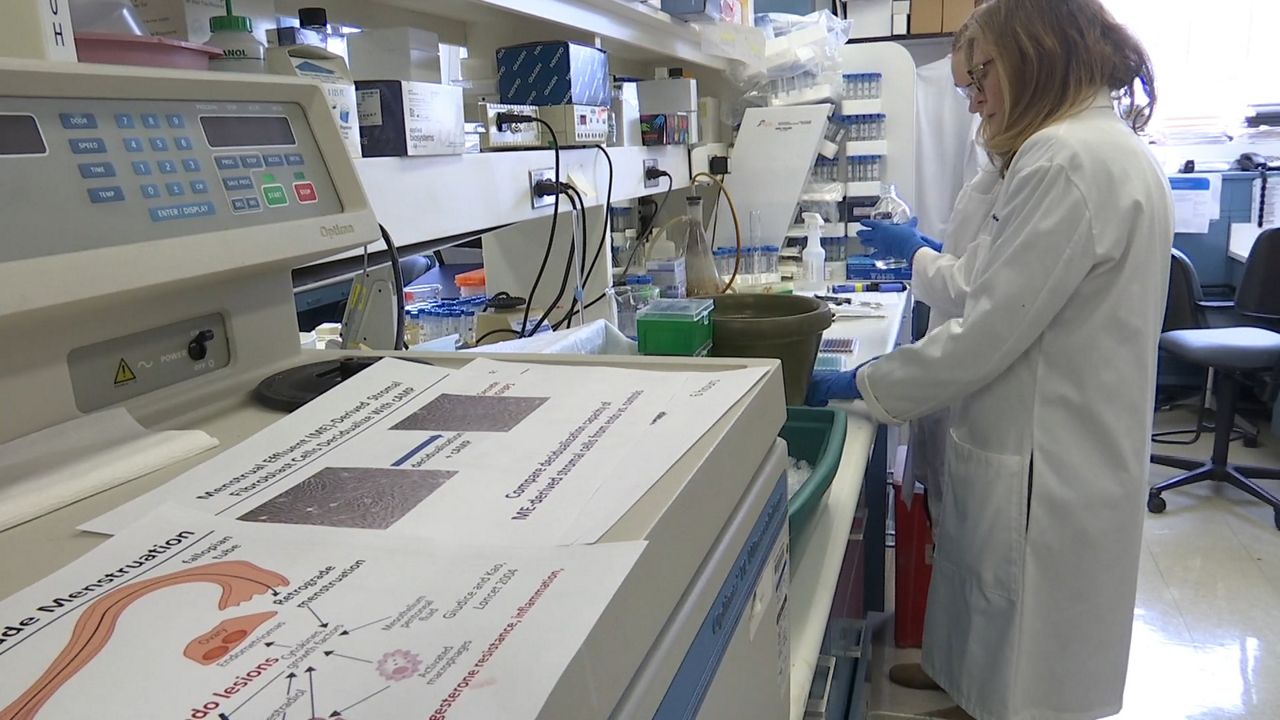From the moment Sarah Hillstead had her first period at age 12, her body was under attack.
“When I started menstruating, it was awful,” Hillstead said, describing experiencing heavy bleeding and extreme pain. “I was doubled over in pain. I would pass out.”
Hillstead’s gynecologist at the time told her the symptoms were normal for menstruating women.
At 21, after that doctor retired, Hillstead was assigned a female gynecologist who she said believed her when she described her abnormal pain.
It was then she learned she may have endometriosis, a condition where the endometrium, the lining of the uterus, grows outside of it. Endometrial cells can spread and grow on other organs, causing scarring and intense bleeding and pain, particularly during menstruation.
The condition affects 10-15% of women globally, but there’s only one way to diagnose it: A doctor has to look inside the body through laparoscopic surgery. While she had all the symptoms, her doctor couldn’t officially diagnose her.
“My insurance was like, ‘no, we’re not paying for this because you’re 21 years old, you don’t need surgery,'” Hillstead told Spectrum News. “And so they kept denying me.”
Hillstead, now 43, said that was the moment her life could have taken a very different turn: “I wouldn’t have had to have a hysterectomy. I could have had children.”
When Hillstead was 26, her period came and didn’t stop for 41 days. On a scale of one to 10, she said her pain was a 50.
Doctors said they needed to remove her uterus — so she had to undergo a hysterectomy before she was 30.
It was during that surgery that her endometriosis was officially diagnosed. Hillstead said when doctors opened her up, they discovered the endometrial cells had spread, gluing organs together that shouldn’t have been.
She had to be airlifted, mid-procedure, to a larger hospital equipped with staff capable of handling her case.
A major lag in diagnosis
It typically takes 7-10 years for most people with endometriosis to get an official diagnosis. Standard treatment is excision, which happens at the time of the laparoscopic surgery, if the surgeon locates endometrial lesions through the camera.
“They go in and they actually cut out the lesions because they grow like icebergs, they grow into the tissue,” explained Christine Metz, PhD, a professor at Northwell Health’s Feinstein Institutes for Medical Research.
Many undiagnosed people who menstruate are offered medication, like birth control, to ease symptoms. Those treatments didn’t work for Hillstead. She said a non-invasive test for endometriosis is long overdue.
Metz and her colleagues have been working on that very problem. Their work has revealed how important a simpler diagnostic would be.
“Many of our symptomatic subjects who have joined the study have intentions of undergoing the diagnostic surgery,” Metz said. “ut then they don’t.”
“Some people don’t want to undergo the surgery because they don’t want to have scars,” She explained. “Some people don’t want to undergo the surgery because of the cost, and they don’t have health care. Some people don’t want to undergo the surgery because they’re having difficulty finding a person who will do it.”
The search for an easier way
Spectrum News profiled Metz’s work with the ROSE Study in 2018. At that time, Metz and her colleagues had found markers in menstrual tissues that confirm what researchers have known for some time — that the process of creating a nutritive environment in the womb is defective in people with endometriosis.
But finding those markers turned out to be more of an elaborate undertaking.
“It requires labor to grow the cells,” Metz explained. “Money. It’s a complex assay and then we have a downstream analyses.”
They went back to the drawing board. With the help of single cell RNA-sequencing technology commonly used to analyze cancerous tumors, they found a way to quickly evaluate gene expression patterns in tissues found in menstrual blood.
“We don’t believe that the diagnostic will be a single cell RNA sequencing platform, but we’d like to take the information that we get from a single cell and translate it into a simpler, predictive assay, based on the expression of a few genes in a few cell types,” said Metz.
They are currently enrolling women who have not received an endometriosis diagnosis into another phase of the ROSE Study – symptomatic menstruators who are on the road to laparoscopic diagnostic surgery or those who suspect they could have the disorder.

Researcher Christine Metz is developing a non-invasive way to test for endo
Metz said they plan to apply to the FDA for official diagnostic test status in a year. The test would analyze fresh menstrual effluent, or menstrual blood, which is collected through a menstrual cup or a sponge.
“We have this vision that someday the analysis of menstrual effluent will be part of a gynecologic exam. Women will collect their menstrual effluent at home and drop it off at the lab or FedEx it to the lab,” said Metz. “We can process it immediately and have results within a day or two. So it would be very rapid and inexpensive.”
Nineteen surgeries later, Hillstead has learned so much more about her body and her extreme case of endometriosis. She was an early participant in the ROSE Study and has since discovered that endometrial cells have spread to her heart, inside her lungs and as far as her brainstem.
“It still sheds every month. So I get severe pain every month,” said Hillstead. But she says she manages it, through regular massages, chiropractic appointments and spending time with her dog Jack Jack.

Sarah Hillstead has struggled with endometriosis since age 12
All of Hillstead’s pain may have been avoided if she had received treatment when she was a teenager. She said she hopes that young people who menstruate will soon gain access to earlier and less invasive treatments.
“Women should not have to fight every single day,” said Hillstead. “I don’t want people to suffer like I’ve suffered and am suffering.”
Metz estimates about 40% of women who have trouble getting pregnant or staying pregnant have endometriosis, but there are so many other causes of infertility. For all of human history, menstrual blood has been viewed as taboo, something to discard.
But Metz said what is remarkable is it may hold the answer to many questions surrounding infertility. If her diagnostic test gets approved, it could be the beginning of a new era in women’s medicine.
“It will be a window into understanding the endometrium and the uterus in ways that we have never been able to investigate before,” said Metz. “I think infertility is such a clear and obvious condition, that we believe menstrual effluent or menstrual blood would be able to tell us something about that.”




